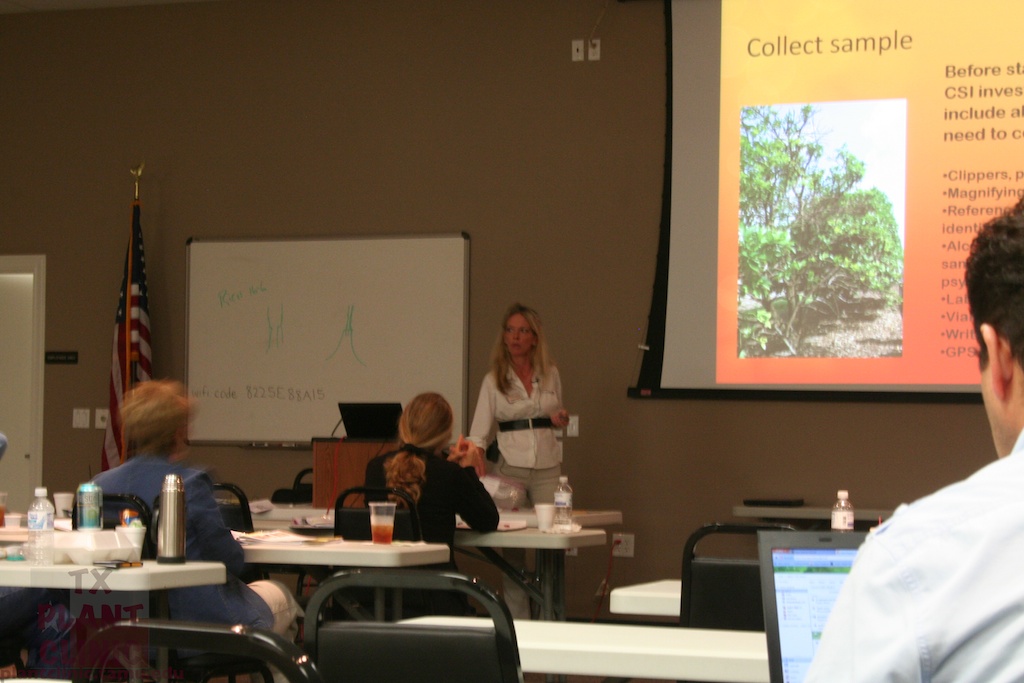
The 2012 Master Gardener Specialist – Citriculture training.
One of the most robust programs for volunteers is the Master Gardener program in Texas (Texas A&M Agrilife Extension). This is where folks who are interested in gardening register to take classes from various experts in plants, plant health management and horticulture. (Check out their website at http://txmg.org ). To help with some of the continuing education efforts for these valuable volunteers, there is the Master Gardener Specialist program which provides a little more “bulk” information and training to these volunteers in various areas of gardening such as vegetable growing and entomology. This year, the Texas Plant Disease Diagnostic Lab will partner with the Master Gardener program to conduct a Master Gardener Specialist program for Plant Diseases. The specific program that will be conducted is partially funded by a federal grant and allows for participants fees to be subsidized. To register for this program, you can do so online at http://agriliferegister.tamu.edu (Search for Master Gardener). The tentative agenda can be found at the registration site. Registration fees are $125 for early registration (ending 5/31/2013) and $175 after that (registration will close on 6/17/2013)
The Master Gardener Specialist FIRST DETECTOR-Plant Disease program will be held in College Station on June 24 -26, 2013. It will be a training program packed with information, including diagnostic and information collecting skills and practices. Below are answers to some FAQ’s regarding the program. If you have other questions, you can email them to us at plantclinic@ag.tamu.edu (add in Subject: MGSpecialist).
FAQ. (Downloadable FAQ file in PDF)
What is the First Detector program?
The National Plant Diagnostic Network(NPDN) was established in 2002, to respond to the need for enhanced agricultural security through protecting the health and productivity of plants in agricultural and natural ecosystems in the U.S. The First Detector Training program is a national program established by the NPDN to promote the early detection of invasive and exotic pathogens and pests through education and enlisting the help of citizen “scientists”.
Why the TX Master Gardener Specialist program?
The Master Gardener Specialist program is an established program in which interested Master Gardener volunteers can enhance their knowledge in specific areas and volunteer their time to gain that knowledge (20 volunteer hours are required for completion).
What is the Master Gardener Specialist First Detector –Plant Disease program?
For quite a few years, Master Gardeners and County Agents have requested that I develop a Master Gardener Specialist program in Plant Pathology. However, this was difficult as it would be time-consuming and tedious to prepare and conduct a practical class that would have several pathogens available at one time (culturing and maintaining bacterial, fungal and nematode cultures is tedious). However, the First Detector (FD) program allows for us to focus on one particular emerging problem and, at the same time, address some related problems. The MG Specialist First Detector – Plant Disease program is also a federally funded project, enabling us to develop and prepare some materials for this program. The 2013 summer training will focus on an emerging disease “boxwood blight” which has not been found in Texas. Because this is a landscape plant, we will also be studying several new and emerging landscape disease problems (potentially rose rosette and impatiens downy mildew).
What else will be covered in this training program?
The FD- Plant Disease program will cover the importance of monitoring for high risk pests, basic plant disease diagnostic skills, proper methods and procedures to sample and submit a diagnostic sample, photography for diagnostics, methods for preventing the introduction of diseases of concern and other related disease problems.
There is a 20-hour volunteer requirement to complete the program. How do we complete this requirement?
There will be several different tasks that can be used to gain the 20 hours needed for the completion of this program. This would include, but is not limited to:
- Surveying and observation exercise – With boxwood blight being the focus, participants will identify and tag locations (using GPS and maps) where boxwoods are planted in the immediate circle of influence. The participant should know the proper protocol if suspicious specimens are found.
- Provide/conduct educational awareness programs on invasives (ie. delivering talks on why it is important to keep our eyes open for undesirables in the garden).
- A limited # of hours can be earned by handling or providing disease and plant problem support (through site visits or other forms of communications).
Would this training be useful since we do not have boxwood blight in this state?
Yes. The disease boxwood blight is used as a model for focus, but participants will learn basic on-site diagnostic skills. Participants will also get to practice some of the observational and information collecting skills (survey and photography) at this training. The principles learned in this training session are applicable to many different pests, pathogens, and weeds.
What is the plan for this training?
This will be a somewhat intense program beginning at 1pm on Monday (June 24) and ending on Wedneseday (June 26) at 12pm. The class will be held at the Horticultural and Forest Science Building on the Texas A&M University campus. There will be a welcome reception on Monday evening at a TBA off-site location. Lunch on Tuesday will be catered to help us utilize our training time efficiently. There will be a tour to the Texas Plant Disease Diagnostic Lab (one of the NPDN labs in Texas) to allow participants to see and learn about the inner workings of a diagnostic lab.
Where do we stay?
We are in the process of setting up a couple of hotels that have shuttles to transport participants to the HFSB building (training site) as parking on campus can be an issue. We should have hotel information shortly (by 6/1/2013).
If I want to drive, where do I park?
We will also send out maps to the training site and parking information to participants as the training gets closer.


